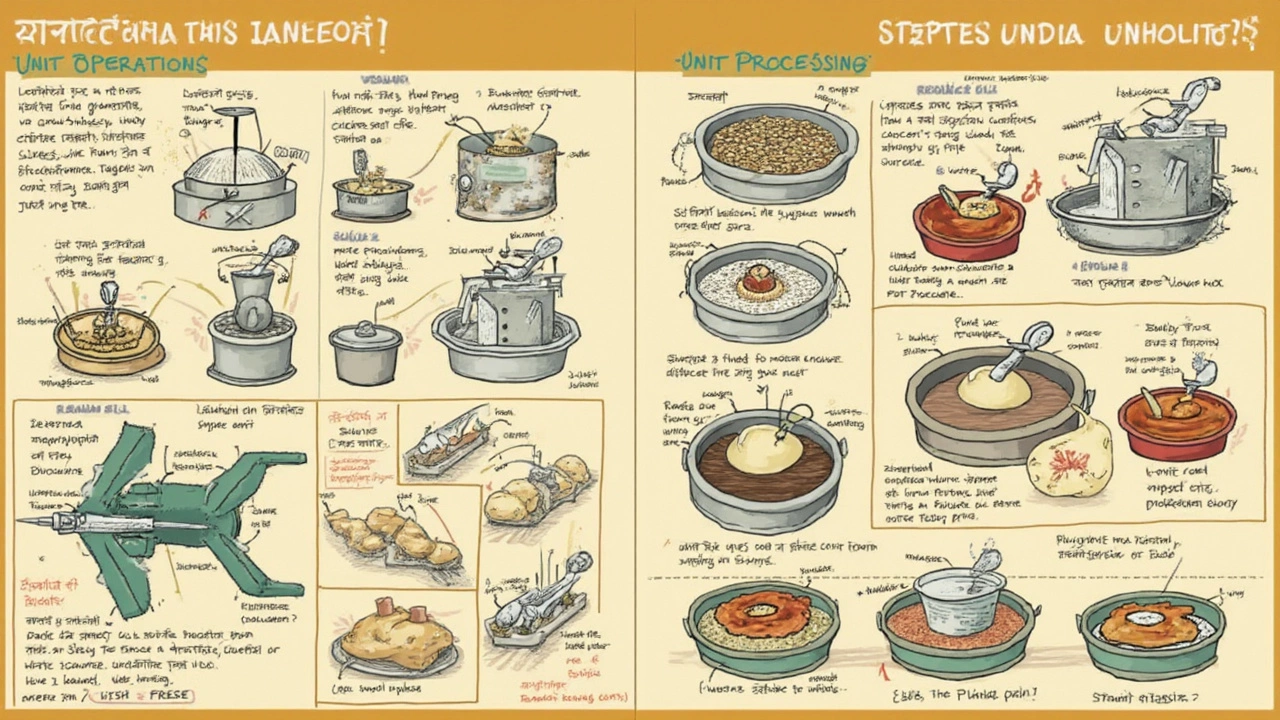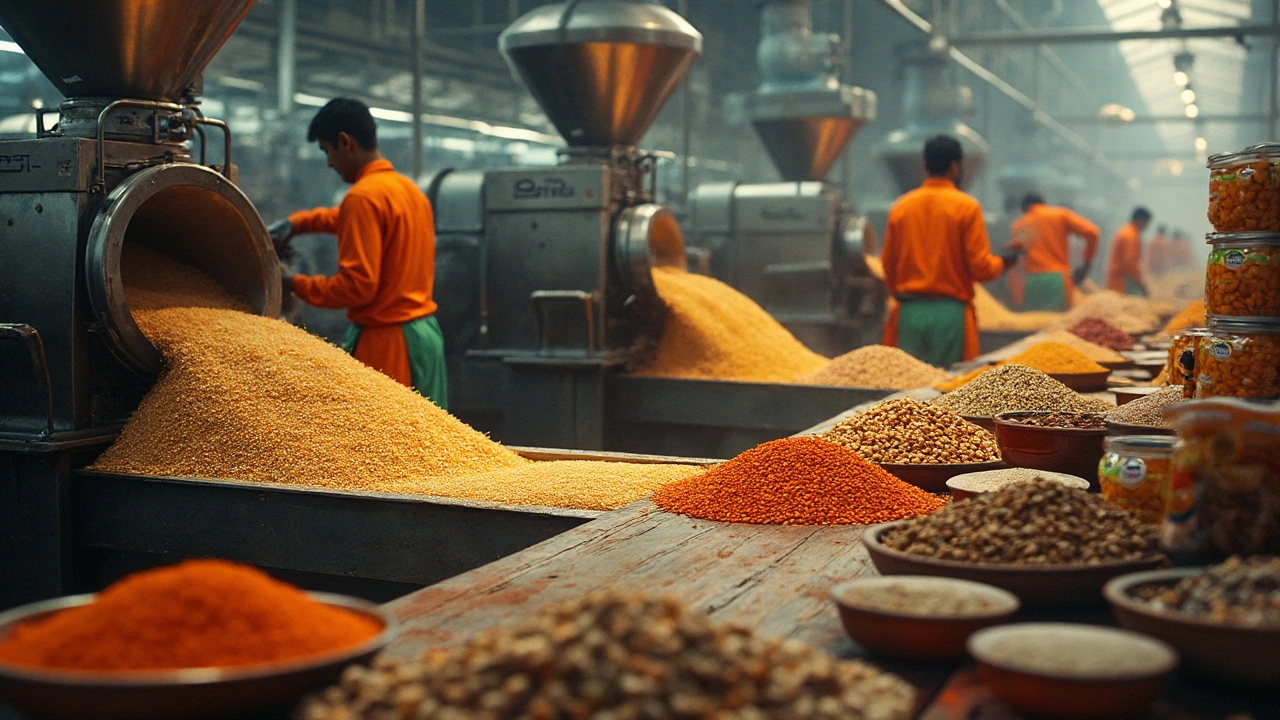Ever stared at a bag of chips and wondered what happens behind the scenes before it lands on the shelf? There’s a ton of science and planning involved, especially when you zoom in on things called unit operations and unit processing. These aren’t just buzzwords that food engineers toss around. They’re the basic building blocks for how pretty much all our food gets made—whether it’s fresh, frozen, or microwavable.
Here’s the deal: unit operations are the simple, physical actions. Stuff like mixing, cutting, or chilling. Nothing in the food changes except its shape or temperature. Unit processing, on the flip side, is when an actual change happens in what the food is made of—think of turning dough into bread by baking it. That’s a chemical change, not just a physical one.
Plenty of folks in food plants—even the ones wearing lab coats—still mix these up sometimes. But if you want to understand why your cereal always comes out crunchy or why milk lasts way longer than it did a century ago, these two ideas are what make everything tick. Let’s break them down and get into why they matter way more than you might expect.
- Getting Clear on the Terms
- Why It Matters in Food Factories
- Real-Life Examples You Eat Every Day
- Cutting Down Mistakes and Waste
- Tips for Smarter Processing Choices
Getting Clear on the Terms
If you take a peek at any food factory, you’ll see all sorts of gear: slicers, mixers, fryers, and ovens. Each does a job, but not all jobs are created equal. In food processing, folks usually split everything into two big groups: unit operation and unit processing. Both are steps in making food, but they’re not the same thing.
Unit operation means a simple, physical task. No matter how wild it looks—mixing, grinding, sifting, evaporating—the food's ingredients don’t change on a chemical level. Picture washing potatoes: the water might knock some dirt off, but those potatoes are still potatoes. Even freezing beef keeps it as beef—it just gets colder and firmer for storage, nothing inside really changes.
Unit processing, though, is a total game changer. This is where science kicks in. When you bake bread or ferment yogurt, the food’s makeup transforms. Sugar breaks down, proteins get reshuffled, brand new flavors or textures show up. These are chemical or biochemical shifts that just won’t happen with plain ol’ cutting or heating.
Here’s how Professor S. S. Deshpande, a known voice in the food tech world, puts it:
"Unit operations are the backbone for large-scale food handling, while unit processes are why our food lasts longer and tastes so different from its original form. Without both, there’s no modern food industry."
So, if you’re trying to wrap your head around this for a test or your job, remember:
- Unit operation: Physical shift, no new substance made. (Example: filtering juice)
- Unit processing: Chemical or biochemical change, totally new stuff gets formed. (Example: turning milk to cheese)
Mixing these up can honestly mess up product safety, taste, or even safety checks, so getting them right matters more than you might think.
Why It Matters in Food Factories
This isn’t just tech-speak for food engineers. Understanding the difference between unit operation and unit processing literally drives every decision inside a factory. If the team can’t tell if they’re just chopping a carrot (unit operation) or fermenting cabbage into sauerkraut (unit processing), the end product can flop—and the company can lose a ton of money.
Food safety is the big one. Let’s take pasteurization. That’s a unit processing step for milk, where bacteria are killed by heat. Skip or mess up this process, and you risk making people sick. But if you’re only bottling the already pasteurized milk (a unit operation), there’s no new chemical change—yet there’s still a huge focus on cleanliness and speed. Each step has different quality and legal rules.
"Without precise control over unit operations and unit processes, food factories risk not just their profits, but public health and brand trust." — Institute of Food Technologists
On top of safety, efficiency is king. Take a look at this quick table showing why getting it right matters for both cost and quality:
| Step | Unit Type | Key Risk If Mismanaged | Extra Cost Per Batch* (USD) |
|---|---|---|---|
| Mixing flour & water | Operation | Poor texture or dough lumps | $200 |
| Baking bread | Processing | Raw or undercooked product, food safety issues | $500+ |
| Packaging | Operation | Contamination risk, broken seals | $150 |
*Based on industry averages for every 1,000 kg of product made.
For the folks running the lines, knowing which step is which helps them pick the right machines, set correct timers, and stop expensive mistakes before they start. Some places even use software with color-coded dashboards—blue for unit operations, red for unit processing—so everyone knows what’s happening at each step. That’s how companies keep their products consistent, safe, and affordable.
- If a unit processing step gets skipped, like not fermenting yogurt long enough, the taste and safety can tank.
- If a unit operation is sloppy, like not chilling salad greens right away, the food goes bad faster and shoppers complain.
So, yeah, these aren’t just academic terms—they’re what keep your food tasty and safe, batch after batch.

Real-Life Examples You Eat Every Day
The best way to get a grip on unit operation and unit processing is by looking at stuff you actually eat. Seriously, you see these principles at work every time you walk down a grocery aisle.
Let’s start with milk. Pasteurizing milk is unit processing—it kills off bacteria by heating the milk and changing its properties. But chilling the milk right after? That’s unit operation. All you’re doing is dropping the temperature, no chemical changes involved. It’s a tag-team effort that makes your milk safe and fresh for longer.
Bread has the perfect duo as well. Slicing the loaf so it fits in your toaster is classic unit operation: only the shape changes. Baking the dough in the first place, though, is unit processing. The heat causes a chemical reaction that transforms sticky dough into fluffy bread.
Ever think about French fries? The potatoes get washed (another unit operation), then sliced (you guessed it—unit operation), but when you toss those strips in hot oil and they turn golden brown, that’s unit processing in action. The Maillard reaction, which gives fries their crunch and flavor, can’t happen without actual chemical changes inside the potato.
Need a quick look? Check out this comparison for how common foods go through both types of steps:
| Food | Unit Operations | Unit Processing |
|---|---|---|
| Milk | Filtration, Chilling, Homogenization | Pasteurization, Fermentation (yogurt) |
| Bread | Kneading, Slicing, Packaging | Baking, Fermentation |
| French Fries | Washing, Peeling, Cutting | Blanching, Frying |
| Canned Beans | Sorting, Washing, Filling Cans | Sterilization, Cooking |
This isn’t just fun trivia. Understanding where physical steps (like cutting or cooling) end and chemical changes (like cooking or fermenting) start helps food companies fine-tune quality, food safety, and even the price you pay at the store. For example, speeding up a unit operation can make a factory quicker, but if you rush a unit processing step like pasteurization, you could end up with spoiled milk or unsafe food—definitely not what anyone wants in their cereal bowl.
Cutting Down Mistakes and Waste
If you want to keep a food plant running smoothly, cracking the difference between unit operations and unit processing is huge—both for your wallet and for the planet. Every small mistake, whether you're mixing, heating, or fermenting, can lead to major waste and lost money. That’s why so many companies focus on cutting down errors in these steps.
Take baked goods as an example. Mess up the mixing (a unit operation) or the baking (a unit process) and you get loaves that can’t even be sold. According to a 2023 report from the Food Waste Reduction Alliance, commercial bakeries in the US throw out up to 5% of their production just because of processing mistakes that could have been caught earlier.
Food engineers use checklists, sensors, and even cameras to spot slip-ups fast. They look for temperature swings during pasteurization, weird mixing times, or off-color batches. When you know which part is a unit operation versus a unit process, it’s easier to troubleshoot:
- If the bread is burnt, check the baking unit process—not the cutting unit operation.
- If salad greens keep getting bruised, focus on the washing and handling operations.
Here's a quick comparison of typical mistakes and where they sneak in:
| Step | Unit Operation or Unit Processing? | Common Mistake | Result |
|---|---|---|---|
| Mixing dough | Unit Operation | Too little time | Dense bread |
| Baking bread | Unit Processing | Temp too high | Burnt crust |
| Chilling milk | Unit Operation | Chiller fail | Spoilage |
| Pasteurizing milk | Unit Processing | Time too short | Bacteria survive |
Even a small drop in food waste makes a huge difference. The United Nations says that cutting food loss by only 1% could keep millions of meals out of landfills. This is why food companies put so much effort into mastering every unit operation and processing step.
“Mistakes in food processing are expensive, not just for business but for the environment. Paying attention to every detail, step by step, is how we cut waste and keep costs down.”
International Journal of Food Science
At the end of the day, the trick isn’t just in knowing the fancy terms, but in using them to find and fix trouble spots. Fewer errors mean less wasted food on the plant floor and fresher products on your table. And that’s really where the power of understanding unit operation and processing pays off.

Tips for Smarter Processing Choices
Making food on an industrial scale isn't just about giant machines. It’s about picking the right process for every stage, whether you’re doing a unit operation like slicing apples or a unit processing step like pasteurizing milk. One wrong move can send costs way up or mess with the quality of your end product. Let’s get real about how you can do it smarter.
First, know where to use each method. If you just need to make food pieces smaller or separate solids from liquids, stick to unit operations—they’re almost always cheaper and faster since you're not changing the chemistry. But whenever you need new flavors, textures, or to kill bacteria, you’re in unit processing territory. Here, you want the safest and most efficient method, whether that's baking, fermenting, or sterilizing.
- Keep an eye on energy use: A 2022 industry survey found that thermal operations (like baking or pasteurizing) can eat up to 30% of a food factory's energy bill. If you can swap a chemical change for a physical one—like using a centrifuge instead of excessive heating—you might save a chunk of cash.
- Watch processing times: Shortening time at each stage means less product spoilage. For instance, reducing pasteurization time (using flash pasteurization) can cut nutrient loss by as much as 20% while still keeping milk safe.
- Match your process to your product goals: Want extra-crunchy chips? Focus on moisture removal. Need a longer shelf life? Go for chemical changes like canning or pickling, but weigh them against how they affect taste and nutrients.
Here’s a quick snapshot to help decide which process fits best for common food products:
| Food Product | Main Unit Operation | Main Unit Processing Step | Best Choice for... |
|---|---|---|---|
| Sliced Bread | Mixing, Slicing | Baking (chemical) | Texture, Flavor |
| Orange Juice | Juicing, Filtration | Pasteurization | Safety, Shelf Life |
| Potato Chips | Cutting, Washing | Frying (chemical/physical) | Crispiness |
| Milk | Homogenization (physical) | Pasteurization (chemical/thermal) | Uniformity, Safety |
Staying sharp about these choices isn't just for the “big guys.” Even smaller producers can slash costs and boost quality just by knowing when to swap out one process for another. Also, regular team training goes a long way. People who know what each process does are much less likely to make expensive mistakes, like letting something ferment too long or using the wrong slicer.
The bottom line: ask two questions at each step—can I get by with a unit operation, or do I need a unit processing step to hit my goals? Making the smartest pick every time means better food, less waste, and usually, more money in your pocket at the end of the month.






